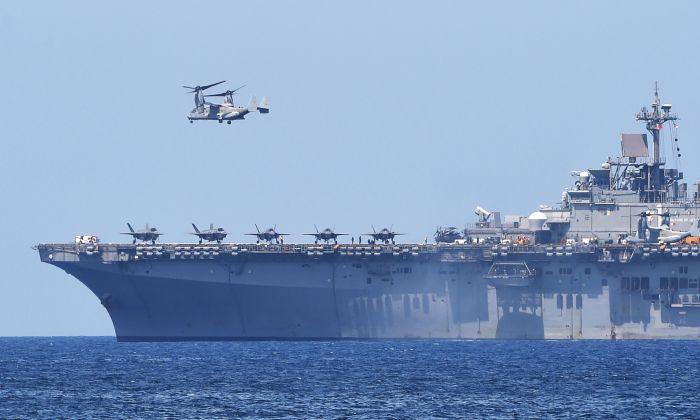The United States and the 10 nations of the Association of Southeast Asian Nations (ASEAN) in a historic first kicked-off joint-naval exercises in the Gulf of Thailand.
China has had
decades of institutionalized security cooperation with ASEAN and held ASEAN-China naval exercises last October. China unsuccessfully tried in 2014 to ban ASEAN members from holding U.S. exercises by proposing a “Single Draft Negotiating Text” for its proposed “Code of Conduct with ASEAN” that “parties shall not hold joint military exercises with countries from outside the region, unless the parties concerned are notified beforehand and express no objection.”
ASEAN was formed in 1967 and now includes Brunei, Cambodia, Indonesia, Lao PDR, Malaysia, Burma, Philippines, Singapore, Thailand and Vietnam. But the treaty members, with a combined 651 million population, became concerned in 2009 when China submitted to the UN Commission a map with a U-shaped “nine-dash line” extending about 1,200 miles (2,000 kilometers) south of its mainland to claim “
historic maritime rights” to about 90 percent of the South China Sea waters.
The Philippines sued and
won a U.N. legal judgment denying China’s claims in 2016, but Chinese leader Xi Jinping refused to accept the authority of the court. Despite promising in 2015 to refrain from militarizing the area, China created seven artificial islands and then installed radar jamming equipment and long-range anti-ship and anti-aircraft missiles on Fiery Cross Reef in the disputed Spratly archipelago.
With 30 percent of world maritime trade and about half of all global oil tanker shipments passing through the South China Sea each year, it is a vital U.S. interest to prevent attempts to restrict “freedom of navigation” for American or global trade vessels.
U.S. Chairman of the Joint Chiefs of Staff General Joseph F. Dunford Jr.
stated in late May that China violated its promise of South China Sea peaceful use by installing 10,000-foot runways, setting up ammunition storage facilities and installing area-denial missile systems. Chairman Dunford also complained that the Chinese Navy and merchant marine forces had shadowed and harassed U.S. military vessels in the area.
The five-day joint ASEAN-U.S. Maritime Exercise (AMUX) involves at least eight ships, four aircraft, and over 1,200 naval personnel. At the Sattahip naval base in eastern Thailand’s Chonburi Province opening ceremonies, Royal Thai Navy Fleet’s Chief of Staff Vice Adm. Chareonpol Koomrasi
said the exercise are aimed at enhancing the capability of ASEAN naval forces in dealing with common maritime threats and natural disasters, such as drugs, illegal arms trade and human trafficking.
U.S. Rear Adm. Kenneth Whitesell said the eleven-nation multilateral exercise demonstrates America’s commitment to free and open Indo-Pacific passage to counter China’s efforts to expand its
territorial claims in the South China Sea.
The AMUX exercise area extends to the tip of Vietnam’s southernmost province of Ca Mau in an area known for piracy. The initial drills involve forming of a combined task force and simulation of different scenarios that included search, boarding and seizure.
U.S. Rear Adm. Joey Tynch as Commander of Task Force 73, which oversees theater security for the U.S. Navy in Southeast Asia,
told the USNI that the Navy has been conducting exercises, port visits, and engagements in Southeast Asia for decades, but AUMX represented a step forward in the trend of multilateral cooperation activities.
Tynch added that ships and aircraft are organized into a combined task force structures to simulate real-world scenarios that require working together to best leverage forces: “When we kicked this off, we gave the planners a challenge—that this AUMX was not going to be a symbolic event, that we needed an exercise that would provide value for each of the countries.”
Chriss Street is an expert in macroeconomics, technology, and national security. He has served as CEO of several companies and is an active writer with more than 1,500 publications. He also regularly provides strategy lectures to graduate students at top Southern California universities.






Friends Read Free